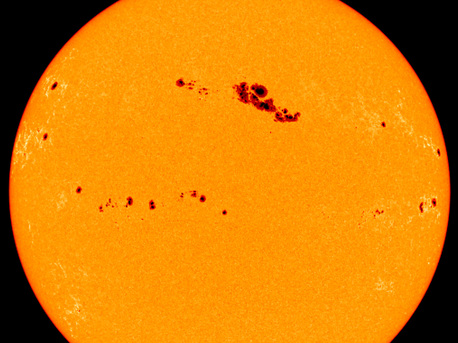Learn about Sun Spots
Why does the Sun have black spots?
 © NASA
|
The spacecraft SOHO (Solar and Heliospheric Observatory) took this picture of the Sun's surface, showing an unusually large number of sunspots, in March 2001. Sunspots are caused by differences in temperature on the Sun's surface: cooler points appear as black spots.
'Somewhat cooler' refers to the average surface temperature of around 6000 degrees Celsius. The core area of the spots (the umbra) is 'only' 4000 degrees Celsius, the peripheral area (the penumbra) is a good 5000 degrees Celsius. At these temperatures, the spots are also white hot, however the difference in temperature causes the light to be filtered and the spots appear black.
The number of sunspots fluctuates significantly
The incidence of sunspots is related to the level of the Sun's activity and changes in an 11-year cycle. During a minimum of the sunspot cycle there are often periods of several months during which no spots can be seen. At a sunspot maximum there can be hundreds of them. The spatial distribution of the spots across the Sun's surface and their magnetic orientation change during an 11-year cycle. Consequently, a complete sunspot cycle actually takes 22 years.German Aerospace Centert
Learn about Sun Spots
Why does the Sun have black spots?
 © NASA
|
The spacecraft SOHO (Solar and Heliospheric Observatory) took this picture of the Sun's surface, showing an unusually large number of sunspots, in March 2001. Sunspots are caused by differences in temperature on the Sun's surface: cooler points appear as black spots.
'Somewhat cooler' refers to the average surface temperature of around 6000 degrees Celsius. The core area of the spots (the umbra) is 'only' 4000 degrees Celsius, the peripheral area (the penumbra) is a good 5000 degrees Celsius. At these temperatures, the spots are also white hot, however the difference in temperature causes the light to be filtered and the spots appear black.
The number of sunspots fluctuates significantly
The incidence of sunspots is related to the level of the Sun's activity and changes in an 11-year cycle. During a minimum of the sunspot cycle there are often periods of several months during which no spots can be seen. At a sunspot maximum there can be hundreds of them. The spatial distribution of the spots across the Sun's surface and their magnetic orientation change during an 11-year cycle. Consequently, a complete sunspot cycle actually takes 22 years.German Aerospace Centert









